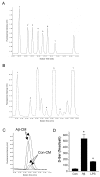Induction of serine racemase expression and D-serine release from microglia by amyloid beta-peptide
- PMID: 15285800
- PMCID: PMC483052
- DOI: 10.1186/1742-2094-1-2
Induction of serine racemase expression and D-serine release from microglia by amyloid beta-peptide
Abstract
BACKGROUND: Roles for excitotoxicity and inflammation in Alzheimer's disease have been hypothesized. Proinflammatory stimuli, including amyloid beta-peptide (Abeta), elicit a release of glutamate from microglia. We tested the possibility that a coagonist at the NMDA class of glutamate receptors, D-serine, could respond similarly. METHODS: Cultured microglial cells were exposed to Abeta. The culture medium was assayed for levels of D-serine by HPLC and for effects on calcium and survival on primary cultures of rat hippocampal neurons. Microglial cell lysates were examined for the levels of mRNA and protein for serine racemase, the enzyme that forms D-serine from L-serine. The racemase mRNA was also assayed in Alzheimer hippocampus and age-matched controls. A microglial cell line was transfected with a luciferase reporter construct driven by the putative regulatory region of human serine racemase. RESULTS: Conditioned medium from Abeta-treated microglia contained elevated levels of D-serine. Bioassays of hippocampal neurons with the microglia-conditioned medium indicated that Abeta elevated a NMDA receptor agonist that was sensitive to an antagonist of the D-serine/glycine site (5,7-dicholorokynurenic acid; DCKA) and to enzymatic degradation of D-amino acids by D-amino acid oxidase (DAAOx). In the microglia, Abeta elevated steady-state levels of dimeric serine racemase, the apparent active form of the enzyme. Promoter-reporter and mRNA analyses suggest that serine racemase is transcriptionally induced by Abeta. Finally, the levels of serine racemase mRNA were elevated in Alzheimer's disease hippocampus, relative to age-matched controls. CONCLUSIONS: These data suggest that Abeta could contribute to neurodegeneration through stimulating microglia to release cooperative excitatory amino acids, including D-serine.
Figures


 0.005)] B. HAPI microglial cell line treated with 15 μM Aβ1–42. C. N9 microglial cell line treated with 300 ng/mL LPS or 10 nM sAPPα695.
0.005)] B. HAPI microglial cell line treated with 15 μM Aβ1–42. C. N9 microglial cell line treated with 300 ng/mL LPS or 10 nM sAPPα695.




References
-
- Jansen KL, Faull RL, Dragunow M, Synek BL. Alzheimer's disease: changes in hippocampal N-methyl-D-aspartate, quisqualate, neurotensin, adenosine, benzodiazepine, serotonin and opioid receptors--an autoradiographic study. Neuroscience. 1990;39:613–627. doi: 10.1016/0306-4522(90)90246-Z. - DOI - PubMed
-
- Fitzjohn SM, Morton RA, Kuenzi F, Rosahl TW, Shearman M, Lewis H, Smith D, Reynolds DS, Davies CH, Collingridge GL, Seabrook GR. Age-related impairment of synaptic transmission but normal long-term potentiation in transgenic mice that overexpress the human APP695SWE mutant form of amyloid precursor protein. J Neurosci. 2001;21:4691–4698. - PMC - PubMed
Grants and funding
LinkOut - more resources
Full Text Sources

